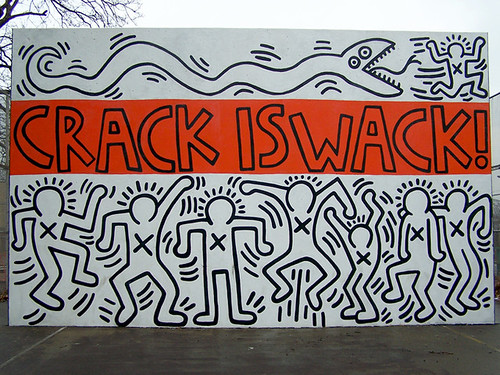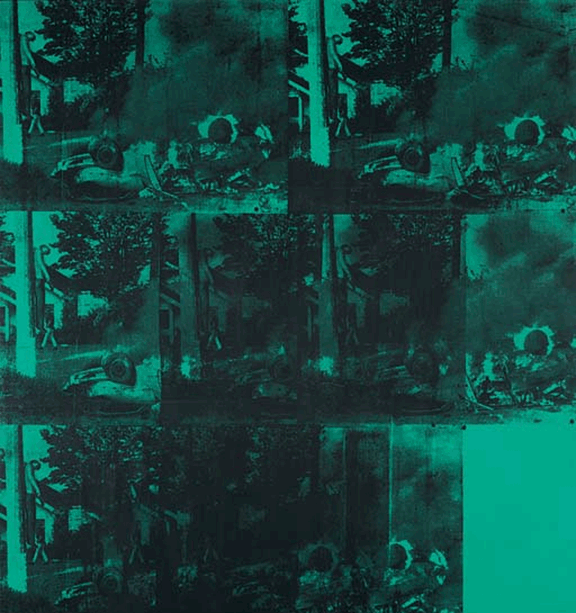In flipping through, I have discovered an interesting section entitled "The Artists' Artists." It's a spread of many pages in which artists write very brief descriptions of what they think is the "Best of 2009." And a few pages in, I have stumbled upon an account of an artist seeing Robert Smithson's Spiral Jetty (1970), which we studied in class and will most likely be on the final tomorrow. Apparently, Florian Maier-Aichen, the artist, saw Spiral Jetty resurface during a fall in water levels after the work had been underwater for nearly four decades.
After looking through that feature, I am coming across pages upon pages of exhibit advertisements. I could literally look through these for hours, which is pretty overwhelming. But now I have found a feature in which thirteen scholars choose their very own top ten best art moments, pieces, or exhibits of the year. And I see that Christine Macel, the chief curator of contemporary art at the Centre Pompidou in Paris, has chosen Roman Ondak's latest exhibit as her number one art highlight of the year. This is interesting to me because I wrote about Ondak's art in my December 2nd entry, which was about the December 2009 issue of Flash Art. This is now the second time that I have discovered an artist while writing in this contemporary art journal, only to come across the artist a second time (the first case was Beatriz Milhazes)! And a few pages later, Matthew Higgs, an artist and curator in New York, chooses Roman Ondak's art as his number five highlight of 2009. It seems that in reading about Ondak last week in Flash Art, I really came across someone to be watching in the future as he appears to be very popular.
And now, after arriving at the final section of the issue, reviews, I see a review on the multiple reinventions of Allan Kaprow's Yard (1961). This seems to be a fitting way to end my contemporary art journal: writing about more contemporary reinventions of a piece of contemporary art that we studied in class this semester.
 Allan Kaprow, Yard, 1961
Allan Kaprow, Yard, 1961Allan Kaprow's original Yard, as shown above, was first exhibited at the Martha Jackson Gallery in New York City, on the Upper East Side, the same location that currently houses William Pope.L's 2009 reinvention of Yard. Before Kaprow's death in 2006, he exercised tight control over the exhibition of Yard, "insisting on reconceiving his environments each time they were shown." However, following his death, artists were finally given the freedom to put their own unique spin on Yard. Pope.L's reinvention, although at the Martha Jackson Gallery, is not exhibited at the exterior site that Kaprow used, because it was built over quite a few years ago. Instead, Pope.L utilizes the entire first floor of the building. Pope.L says that his reinvention has a lot to do with death: the implied environmental decay, the presence of body bags, and Kaprow's absence.
Another reinvention of Yard, that of artist Josiah McElheny, was inspired by Kaprow's speculation about perhaps bringing his audience to the junkyard instead of transporting the tires to Manhattan. In McElheny's reinvention, visitors to the Queen's Museum saw photographs of Willets Point, a nearby area of waste activity, projected onto a wall.
All in all, this review shows that beyond Kaprow's recreations of his own work, artists today are continuing to alter and reinvent his work, showing that Yard is an ever-changing piece. To me, this article has been an interesting look at reinventions within contemporary art because when I think of recreations in art, I imagine artists recreating works from long ago. However, it is now clear to me artists are reinventing works made within the past 50 years. I think this is a good close to my journal as it reveals that contemporary art is vibrant and very much alive.
Buskirk, Martha. "Allan Kaprow, Yard." Artforum 68 (2009): 226.
Another reinvention of Yard, that of artist Josiah McElheny, was inspired by Kaprow's speculation about perhaps bringing his audience to the junkyard instead of transporting the tires to Manhattan. In McElheny's reinvention, visitors to the Queen's Museum saw photographs of Willets Point, a nearby area of waste activity, projected onto a wall.
All in all, this review shows that beyond Kaprow's recreations of his own work, artists today are continuing to alter and reinvent his work, showing that Yard is an ever-changing piece. To me, this article has been an interesting look at reinventions within contemporary art because when I think of recreations in art, I imagine artists recreating works from long ago. However, it is now clear to me artists are reinventing works made within the past 50 years. I think this is a good close to my journal as it reveals that contemporary art is vibrant and very much alive.
Buskirk, Martha. "Allan Kaprow, Yard." Artforum 68 (2009): 226.
































